Canopy for an air conditioner: options for protecting the external unit + arrangement of a canopy
The outdoor unit and compressor are the most expensive part of the air conditioner. They are located in the area most susceptible to mechanical damage.To protect the external module and inter-unit communications from falling icicles, shedding of old plaster, and other troubles, reliable protection is necessary.
We will tell you what an air conditioner hood is and how to install it. The article we have proposed examines in detail the specifics of the design and provides instructions for its installation. Recommendations for operation are given, compliance with which will help extend the service life of the equipment and the canopy itself.
The content of the article:
- Briefly about the design of the air conditioner
- Air conditioner canopy design
- Is it possible to do without a visor?
- How to arrange noise protection?
- What is anti-vandal protection?
- Step-by-step installation of a canopy over an air conditioner
- Features of the heating device
- Caring for the external unit
- Conclusions and useful video on the topic
Briefly about the design of the air conditioner
A household air conditioner consists of two units - indoor and outdoor. The functions of a condenser and an evaporator are clearly distributed between them. The condenser is the outdoor unit, and the evaporator is the indoor unit. These two parts are connected to each other using a line that includes control wires and tubes for refrigerant circulation.
TO internal module a drain pipe is connected to remove condensate. According to the instructions, it must be connected to the sewerage system. There are designs that have several internal units, then they are called multi-split systems, but they are designed according to the same principle.

Mount the outdoor unit in a horizontal manner in all planes. It is necessary that the wind blows over it - when arranging protection, this point must be taken into account. The ideal case is when the outer part of the device is on a balcony or under a curtain.
If the apartment is located on the top floor, the outdoor module is sometimes installed on the roof. This option is possible when the length of the highway does not exceed 1-15 m.
When installing compressor-condensing unit on the wall of the house, a minimum distance of 100 mm is maintained, otherwise in hot weather the compressor may fail due to poor airflow. Not only the part of the air conditioner itself, but also the line connecting both parts of the device must be protected from all kinds of negative influences.
Arguments and guidelines for choosing an air conditioner for furnishing an apartment are given here. We recommend reading useful material.
Air conditioner canopy design
The design of the canopy is simple - a steel sheet with a thickness of at least 2 mm is welded at an angle or screwed using self-tapping screws onto a support unit made of corners. All this is attached to the wall with anchors.
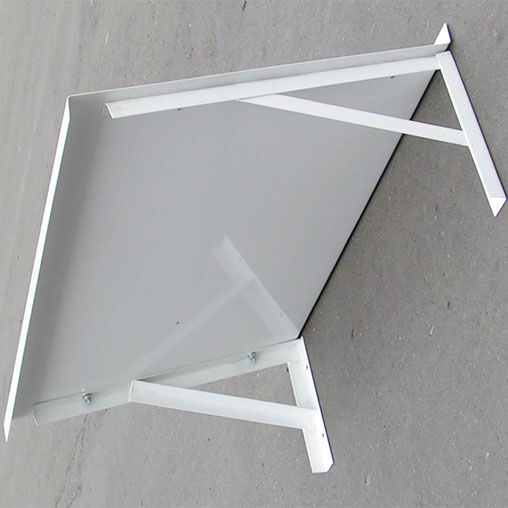
The dimensions of the visor are selected depending on the individual size of the external module of the split system. The optimal dimensions are 100 x 55 cm. The height of the support is 25 cm, the slope is about 70⁰. A popular material for making protection is galvanized steel.
Is it possible to do without a visor?
There are mixed opinions regarding the need for a canopy for a split system. Often, even from specialists, you can hear that its installation is not at all necessary. Really, installation instructions, supplied with the air conditioner, does not require the presence of such a protective device.
The very design of the external module of the device takes into account that it will constantly experience atmospheric influences. It is also taken into account that the heat exchanger and fan blades will be cleared of dust that has settled on them during rain. This is essential to maintain efficient heat exchange.
The visor prevents the heat exchanger from being washed and dirt gradually settles on it, and sometimes birds settle in. On the other hand, pieces of ice falling from the roof actually damage the outdoor unit.
In old houses, collapsing brick parapets and finishing elements are a threat to the external module. Therefore, those who believe that after installing an air conditioner, you need to take care of protecting its outdoor unit are also right.
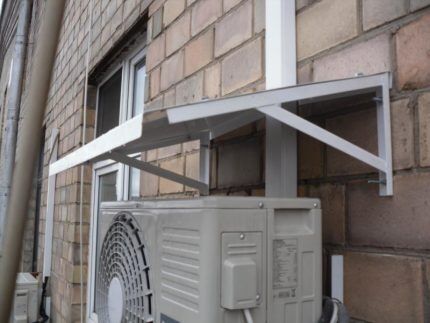
The external module itself may not be damaged by exposure to ice or heavy pieces of trim that have fallen off, but the communication tubes will most likely be damaged.
Repairing and refilling with refrigerant requires a considerable investment, so it is better to install protection for the external unit of your air conditioner and periodically clean the housing - it will cost less. The specifics of independent split system maintenance This is an article that we recommend you read.
How to arrange noise protection?
Often, opponents of installing canopies over air conditioners cite the argument that when raindrops fall on them, noise is created, causing discomfort both for the owner of the equipment and for his neighbors.
There is a solution to this problem - you can stick rubber on the surface. It is an excellent noise absorber.
Some craftsmen create vibration insulation by gluing roofing material or soundproofing tape. For this, silicate glue is used. The surface is degreased before the procedure.
What is anti-vandal protection?
If the apartment is located on the first or last floor, then the issue of protecting the external module from attacks by vandals becomes relevant. Stealing it often simply does not make sense - it is not universal, that is, it is not suitable for everyone split systems.
Therefore, more often there is simply damage for the sake of entertainment. But there are times when, after destroying the outdoor module, tubes made of copper are removed.
In order not to purchase new parts to replace damaged ones, it is better to immediately install anti-vandal protection, which is a metal box with lattice walls, immediately when installing the air conditioner. It encloses the external unit and makes it inaccessible to strangers from the street or the roof.
The grating is made from steel wire with a diameter of 6 to 8 mm. There are no strict requirements for the size of the cells, but it is better to make them no more than 30 mm. The ideal solution is to build a frame from galvanized wire, which does not corrode and retains its aesthetic appearance for a long time.
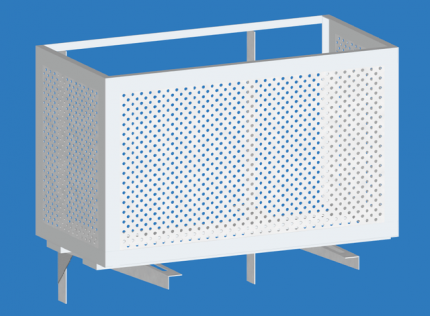
Thanks to the reliable fastening, unauthorized persons will not be able to dismantle both the air conditioner canopy and the anti-vandal protection. You can order such a design according to individual sketches and cover it with polymer paint.
If the outdoor module is placed on the façade of a building and needs to be hidden, a decorative panel that does not have fasteners is a good solution.
Step-by-step installation of a canopy over an air conditioner
Making a visor is quite simple. The process of installing it looks much more complicated. It is better to entrust this work to specialists, but if this is the first floor, then you can do everything yourself by using a stepladder and hiring someone as an assistant.
The crucial point is marking the attachment points with chalk; there should be at least six of them. This operation is carried out using a tape measure and a level.
After marking is completed, take the following steps:
- Take a hammer drill and concrete and metal drills of the required diameter and drill fairly deep holes both in the supporting structure of the canopy and in the wall.
- Choppers are inserted into the holes.
- Drive in anchor bolts with a diameter of 0.8-1 cm.
- Place the holes of the visor onto the threaded part of the anchor so that about 1 cm is left for screwing on the nut.
- Tighten the nut.
To manufacture and install the canopy, you will need an average of 5 m of 25x25x4 mm angle steel, 1 m² of sheet steel, 4-6 pieces of anchor bolts.
In order for the protective canopy to serve for a long time, you need to purchase high-quality material for its construction, and paint the finished product in a light tone. For normal heat exchange, leave a gap of at least 100 mm.
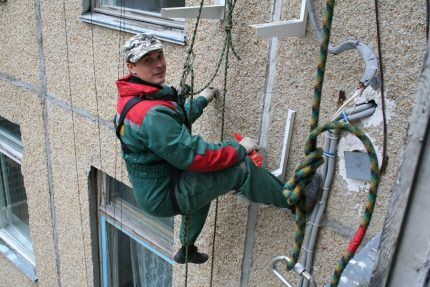
It is better not to install a canopy over an air conditioner located above the second floor yourself. This applies to high-altitude work, which requires special permission. It is usually possessed by industrial climbers.
There are times when, after installing the outdoor module, they forget to remove the transport mesh from its rear wall. Gradually, fluff and dust penetrate into its cells - they remain there, creating a strong layer. When installing the visor, all this must be removed.
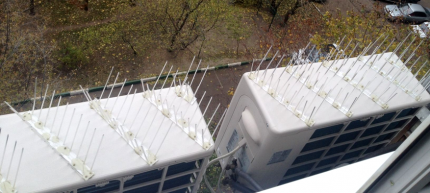
Some companies make soft covers made of mosquito nets to protect the outdoor unit. They protect from dust and poplar fluff, but not from mechanical damage. In addition to these, you will also need to install a canopy.
Features of the heating device
Modern split systems are highly efficient. In some models, one kilowatt spent produces cold or heat in a volume 4 or more times greater.
You can use the air conditioner for heating only down to -5 degrees. At lower temperatures, its heating performance decreases and can drop to zero, although units manufactured by the Japanese companies Daikin and Mitsubishi Electric operate for heating at -25 degrees.
Will familiarize you with the rules for switching the air conditioning system to heat generation next article, which we highly recommend reading.
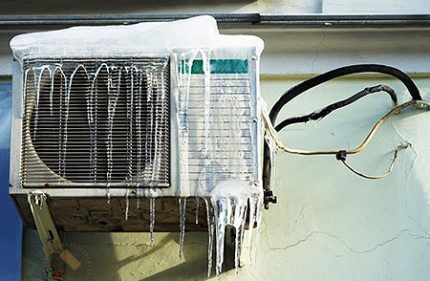
In any case, the air conditioner will not function without effective snow and wind protection for the outdoor unit. Therefore, a durable canopy is mounted over it. To prevent snow from getting into the gap between the wall and the rear panel of the module during strong crosswinds, the sides are also sewn up.
Caring for the external unit
The external part of the split system requires periodic cleaning at least 2 times a year. Air conditioners located between the fourth and eighth floors are almost inaccessible to dust and small organic debris. They can be cleaned at intervals of several years.
The easiest way is to use a powerful vacuum cleaner for this procedure. It will remove dust from external filters and heat exchanger tubes. Since access to the air conditioner is required to perform maintenance, the protective grille is not made solid, but with a door in the front or side of the structure. It is locked and the key is kept only by the owner.
To clean, you need to open the door of the anti-vandal protection box, and then open the module housing. If there is large debris, it is removed with a brush, and even larger debris with a vacuum cleaner. Use a soft bristle brush to clean the filter grille.
When the external module is located at a low height, cleaning is performed from a regular ladder. If a simple device does not provide convenient access to the outdoor unit of the climate system, dismantle the grille and treat the internal contents with a vacuum cleaner and a cloth.
If the significant height does not allow you to clean the outdoor module yourself, you will have to call specialists.
There is another way, but this requires a compressor or a cylinder filled with compressed air. Cleaning is done as follows: push a hose into the housing, and then turn on the compressor or unscrew the valve. Thus, there will be both debris and dust outside the condensate collector housing.
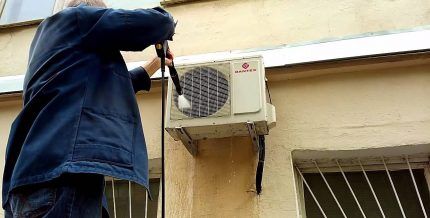
The fact that the external unit needs urgent cleaning is indicated by the appearance of a characteristic knocking sound. This may indicate that the fan blades are difficult to rotate due to clogging or a foreign object that they are clinging to as they rotate. There may also be condensation leaking from the outside of the device.
Especially often, the radiator of the external module becomes clogged with poplar fluff, which reduces the cooling efficiency until the unit completely fails. In this case, cleaning is performed with a water jet. It washes away debris from all hard-to-reach places. Immediately after this procedure, the unit can be put into operation.
Conclusions and useful video on the topic
The process of assembling a protective canopy:
Snow and windproof canopy for the outdoor module:
Having weighed all the advantages and disadvantages of installing a protective canopy, the owner himself must decide on the feasibility of its construction. As practice has shown, when installing a split system, this element should not be neglected. If you are going to use the unit for heating, you will also need snow and wind protection on the sides of the module.
Which visor did you prefer to protect the external unit of your own air conditioner? It is possible that your option was not described in the article we presented. Please leave comments in the block below, share useful information and photos on the topic, and ask questions.




I can say for sure that in our house most of the external air conditioners are unprotected. I also left it like that for a year and a half, until two large pieces of ice like icicles arrived. After that I decided to put up a canopy. I didn’t take the risk myself, I called the experts. True, there are a lot of problems to ensure that there is good ventilation and nothing overheats in the heat. But now I am calm that nothing will crash.
If you make an anti-vandal box from a lattice, then choose a lattice with cells of such size that EITHER even a small bird cannot fly in, OR any bird can fly in and fly out. Otherwise, you may get an unpleasant surprise (For my outdoor unit, I made protection purely in the form of a box of very fine mesh, including the top. I did not make a continuous canopy.This way, I solved two issues at once: the block itself is protected from possible falls of anything (the mesh is quite strong), and during rain there is no such noise as if water were falling on a solid surface.
Tell me, please, does anyone know if it happens that the external unit of an air conditioner has no side wall at all? If you look from the front, there is no sidewall on the left, all the “insides” are visible! This is fine? LG inverter air conditioner.
In panel houses, flowers often appear between the wall and the air conditioner and the wall becomes much more wet. How to avoid this problem? Wouldn't a visor help?